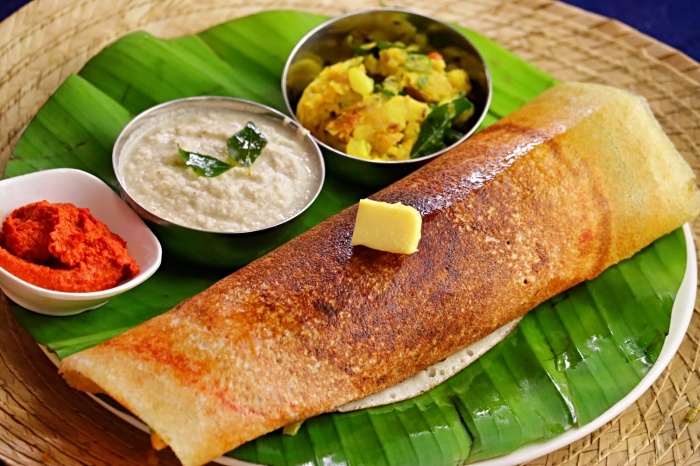
Dosa, a culinary masterpiece that has captured the hearts and taste buds of people across the globe, is a versatile dish that transcends cultural boundaries. With its origins deeply rooted in South India, dosa has earned its rightful place as a beloved delicacy that offers a perfect blend of flavors, textures, and aromas. In this article, we will explore the rich history, diverse variations, and the secret behind the universal appeal of dosa.
Unraveling the Historical Tapestry
The history of dosa is as fascinating as its taste. Dating back centuries, dosa emerged in the southern part of India, particularly in the state of Tamil Nadu. Initially known as “dosai” in Tamil, this dish was traditionally made using a mixture of rice and urad dal (black gram). The batter was left to ferment, resulting in a crispy and tangy delight that delighted palates.
Over time, dosa’s popularity expanded beyond its place of origin, and it became a staple breakfast item not only in Indian households but also in restaurants worldwide. The journey of dosa from a regional dish to an international sensation is a testament to its exceptional taste and adaptability.
Dosa’s Many Avatars
Dosa’s popularity can be attributed to its incredible versatility. From the classic masala dosa to innovative fusion creations, this dish has undergone various transformations to suit diverse tastes and preferences. Here are some of the most notable dosa variations:
1. Masala Dosa: A Timeless Classic
The masala dosa, a cherished classic, is a thin, crispy pancake filled with a spiced potato mixture. The dosa batter is spread thin on a hot griddle, creating a delicate and lacy texture that encases the aromatic potato filling. Served with coconut chutney and sambar (a lentil-based vegetable stew), the masala dosa is a symphony of flavors that continues to captivate food enthusiasts.
2. Rava Dosa: Crispiness Redefined
Rava dosa stands out with its unique texture and preparation method. Semolina (rava) and rice flour are combined with spices and herbs to create a batter that results in a lacy and incredibly crispy dosa. Often enjoyed with a variety of chutneys, rava dosa adds a delightful crunch to the traditional dosa experience.
3. Mysore Dosa: A Spicy Affair
Originating from the city of Mysore in Karnataka, this dosa variation is an explosion of flavors. The dosa is smeared with a fiery red chutney made from red chillies, garlic, and other spices before being filled with the potato mixture. The Mysore dosa’s distinctive taste profile has garnered a dedicated following of spice enthusiasts.
4. Paper Dosa: Delicate and Delicious
True to its name, the paper dosa is paper-thin and incredibly light. This dosa variation is often served in pairs and is known for its delicate texture and large size. It’s a wonderful option for those who prefer a lighter dosa without compromising on taste.
The Secret Behind Dosa’s Allure
What sets dosa apart from other dishes is not only its diverse range of flavors but also its adaptability to different culinary styles and tastes. Its basic ingredients—rice and urad dal—are simple yet hold the key to its universal appeal. The fermentation process the batter undergoes not only enhances the taste but also makes it easier to digest, rendering dosa a wholesome and fulfilling meal.
Dosa’s allure also lies in its accompaniments. The medley of coconut chutney, tangy sambar, and various vegetable fillings complements the dosa’s texture and taste, creating a harmonious blend that satisfies the senses.
Embracing Dosa Globally
As dosa continues to make its mark on international culinary landscapes, it’s clear that its popularity is not bound by geographical constraints. Restaurants across the world are now offering dosa in their menus, often with innovative twists that reflect local ingredients and tastes. From dosa wraps to dosa burgers, the possibilities are endless.
The rise of dosa in global cuisine signifies more than just a food trend. It represents the harmonious amalgamation of cultures through the celebration of flavors. People from different corners of the world are united in their love for dosa, contributing to its journey from a regional dish to a global sensation.
In Conclusion
Dosa, with its rich history, myriad variations, and widespread appeal, has rightfully earned its place as a culinary masterpiece. From the traditional masala dosa to contemporary fusion creations, dosa’s ability to adapt and enchant knows no bounds. Its universal allure lies in its simplicity, versatility, and the unforgettable symphony of flavors it brings to the table. As dosa continues to transcend cultural boundaries, it reminds us that the language of food is one that resonates with all, speaking directly to the heart and soul.
